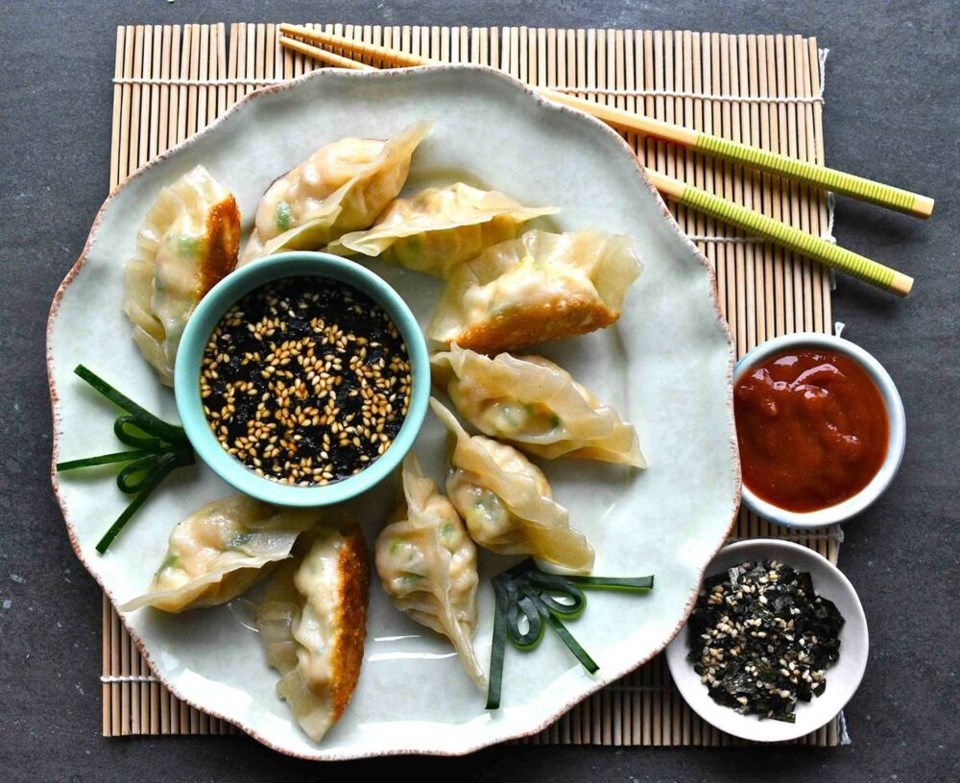I love eating Asian-style dumplings, which explains why over the years I’ve offered a number of recipes for them. And I’m back at again today with one for gyoza.
Gyoza is a Japanese-style dumpling also categorized as a potsticker. A common filling is seasoned ground pork and vegetables, such as cabbage, but they can also be filled in myriad other ways.
To that point, I was at my local seafood shop the other day, the fine looking fresh halibut fillet on display caught my eye, and I decided to use some of it to create a B.C.-fish filled version of gyoza.
To make the filling, I removed the skin on the halibut fillet, finely chopped the flesh, set it in a bowl, and flavoured it with such things as ginger, sesame oil and green onion. The filling was then sealed inside round dumpling wrappers, creating half-moon-shaped gyoza I crimped at the top. The gyoza was then cooked in hot oil a short while, before being covered and steamed with some water.
I served the gyoza with two things you could dip them into or spoon on them. One was spicy chili sauce, the other was citrusy ponzu sauce flavoured with furikake, and Japanese-style seasoning with sesame seeds and bit of nori in it.
Halibut Gyoza
Japanese-style dumplings filled with fine B.C. fish. Serve as an appetizer, or make a meal of them by serving them with rice and sunomono salad or stir-fried vegetables.
Preparation time: 40 minutes
Cooking time: about seven minutes
Makes: about 24 gyoza
1 (325 gram) halibut fillet, skinned removed (see Note 1 and Eric’s options)
3 Tbsp finely chopped green onions (see Note 2)
2 tsp finely chopped fresh ginger
1 Tbsp soy sauce
1 tsp sesame oil
• pinch ground white pepper
1 tsp cornstarch
2 Tbsp vegetable oil (divided)
1/2 cup cold water (divided), plus some for brushing
24 or more fresh, round, dumpling wrappers (see Note 3)
• ponzu sauce with furikake (see recipe below)
• sriracha or other Asian-style chili sauce, to taste
Cut halibut into 1/2-inch cubes. Now finely chop the cubes until the fish almost looks like coarsely ground meat. Set the chopped halibut in a bowl. Add the green onions, ginger, soy sauce, sesame oil, white pepper and cornstarch and mix to combine.
Have ready a small brush and small bowl of cold water. Line a large baking sheet with parchment paper. Place a few dumpling wrappers on a work surface. Dip the brush in the cold water and lightly moisten the edges of each wrapper with it. Place a scant tablespoon of the halibut mixture in the centre of each wrapper. Fold one side of each wrapper over the filling, push out any air, and then tightly press the edges of the wrapper together to form a sealed half-moon. Now fold over and crimp the edges of each gyoza together for a decorative look. Set the gyoza, standing them crimped-side up, on the baking sheet, not touching. Repeat these steps with the remaining wrappers and filling. (You can prepare the gyoza to this point an hour or two before cooking them. Cover and refrigerate until needed).
To cook the gyoza, set two large (mine were 10-inches wide), heavy, non-stick or well-seasoned cast-iron skillets over medium-high heat (see Eric’s options). Pour 1 Tbsp of oil into each skillet. When oil is hot, set 12 gyoza in each skillet, setting them crimp-side-up. Cook the gyoza until golden on the bottom, about 90 seconds.
Lower heat to medium and carefully pour 1/4 cup of cold water into each skillet, being mindful about splatters. Tightly cover and cook gyoza until cooked through, about four to five minutes. Transfer gyoza to a serving platter and serve with ponzu sauce with furikake and sriracha.
Eric’s options: Instead of halibut, try another B.C. fish fillet in this recipe, such as lingcod or rockfish (Pacific snapper). If you don’t have two large skillets, cook the gyoza in two batches in one skillet. Serve the first batch when cooked, or keep warm in a 200 F oven until the second batch is ready, and then serve them all together.
Note 1: Ask your fishmonger to remove the skin on the halibut, or carefully do it yourself with a sharp, thin knife.
Note 2: 1 medium green onion should yield the amount needed here. To finely chop it, cut the green onion, lengthwise, into thin strips. Now line up those strips and cut them widthwise into finely chopped pieces.
Note 3: Dumpling wrappers are sold at Asian food stores and many supermarkets, often by the tofu. I bought them at Fairway Market and the brand was called Double Happiness. The leftover wrappers you’ll have will freeze well.
Ponzu Sauce with Furikake
You can buy citrus/soy-flavoured ponzu sauce at most supermarkets, but it’s easy to make yourself. Here’s my method.
Preparation time: a few minutes
Cooking time: None
Makes: about 1/2 cup
1/4 cup soy sauce (I used Kikkoman brand)
2 Tbsp orange juice
1 Tbsp lemon juice
2 tsp furikake (see Note)
1 1/2 tsp rice vinegar
1 1/2 tsp water
1 1/2 tsp honey
Combine ingredients in a jar. Seal and refrigerate until needed for the gyoza.
Note: Furikake is a Japanese seasoning you can sprinkle on, or add to things, such as salads, rice, soup and sauces. It’s sold at Japanese food stores and in the Asian foods aisle of some supermarkets. I bought it at Fairway Market. If you can’t find it, omit from the recipe and simple serve the gyoza with ponzu sauce not flavoured with it.
Eric Akis is the author of eight cookbooks. His columns appear in the Life section Wednesday and Sunday.



